| Page last updated
23 December 2007 |
What's New with the MUSSELp?
The highlights of 2006.
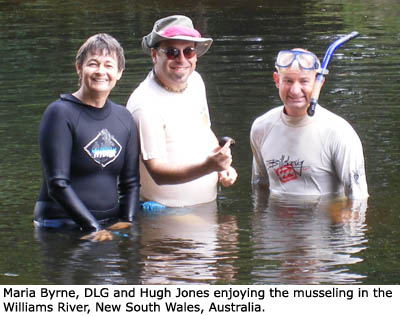 1-9 December 2006. — The MUSSELp Goes Down Under. In honor of the triennial meeting of the Malacological Society of Australasia, we did some collecting in the waters around Sydney, made a big chunk of our database public and gave a lecture. 1-9 December 2006. — The MUSSELp Goes Down Under. In honor of the triennial meeting of the Malacological Society of Australasia, we did some collecting in the waters around Sydney, made a big chunk of our database public and gave a lecture.
After a couple days decompressing in Sydney and adjusting to the 15 hour time difference, DLG and his volunteer assistant Jerry Graf were hosted by Hugh Jones and Maria Byrne of the University of Sydney to some mussel sampling in the Hunter River Basin in northern New South Wales. While the species diversity is low, the freshwater mussels of the genera Hyridella, Alathyria and Cucumerunio were abundant. Tissue samples from three species of Hyridella (H. australis, H. depressa and H. drapeta) were sent back to the Academy of Natural Sciences for molecular analyses.
The rest of the week was spent at the meeting of the Malacological Society of Australasia at the University of Wollongong. DLG presented a talk, "Thinking Globally, but Acting Locally: the MUSSELpdb and the Australasian freshwater mussels (Bivalvia: Unionoida)" to unveil our latest online contribution to freshwater malacology OZ: The Freshwater Mussels of Australasia. That online database makes available all of our specimen records for the unionoids of Australia, New Zealand, New Guinea and the Solomon Islands.
For such a short visit to the Land Down Under, it was a successful trip for making connections with other malacologists, seeing hyriid habitats and disseminating the work of the MUSSEL Project. What a great end to a very busy year!! |
25 July-19 August 2006. — Malacological Sampling While Accompanying the AMNH Ichthyology Crew on the Congo River. We traveled to the Heart of Darkness to improve our malacological understanding of the Lower Congo River, the section below and including Malebo Pool. The original target for this expedition was the Democratic Republic of the Congo, but political instability due to impending elections necessitated moving across the river to the Republic of the Congo. The trip was led and organized by Melanie Stiassny and Bob Schelly of the American Museum of Natural History, New York. |
|
Sampling effort spanned sites from about 15 km above the Pool to just below the village of Bela in the Lower Congo. The habitats of greatest mussel diversity were found in backwaters on the sandy islands in Malebo Pool.

|
Special thanks are owed to the other members of the expedition and our local contacts in the Republic of Congo:
- Victor Mamonekene of Marien Ngouabi University facilitated our collecting in Congo by acquiring the necessary permissions and serving as a knowledgable guide.
- Charles Oumbamahou, local fish exporter, took us on a short expedition up the Congo above the pool.
- Armel Ibala, graduate student at Marien Ngouabi University assisted with logistics, including a last-minute run to meet us at the airport to settle some permitting issues.
- Oliver Lucanus, belowwater.com, was invaluable for his energy, photographic skills and knowledge of French.
- Mikhael Sotnikov, volunteering on behalf of Oliver, brought a considerable amount of energy in support of adventure.
- Jake Lowenstein, AMNH Ichthyology graduate student, provided support to all aspects of the trip, including photo documentation.
Click here to learn more about our sampling sites in the Republic of Congo portion of the Congo River. For the most part, we concluded that habitat for freshwater mussels (and mollusks, generally) in the Lower Congo is concentrated in Malebo Pool.
Click here to see some of the interesting non-malacological aspects of our expedition to the Congo. |
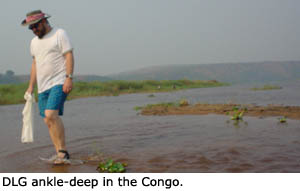
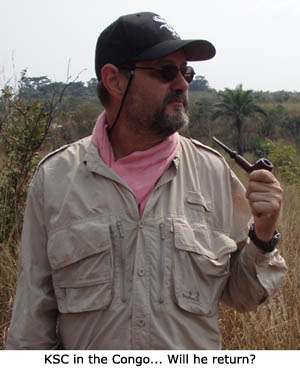
|
Our trip to the Republic of Congo was funded by the National Science Foundation. |
5-30 June 2006. — Katie Vazquez, new Research/Curatorial Assistant funded by the MUSSELp, had a busy first month at the ANSP. Having now visited fourteen major research collections over the past three years in support of the MUSSEL Project, we have accumulated a lot of data: literature, locality records and specimen images. Now we begin a New Era where we can shift our focus from acquiring data to serving data to the malacological community. To help us accomplish that goal, Katie Vazquez, a recent graduate of Northeastern University, joined the MUSSELp team during the first week in June. |
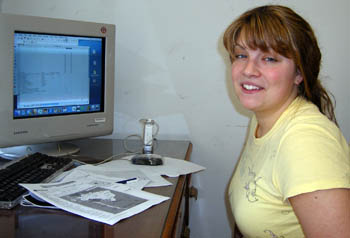
Katie Vazquez, MUSSELp Research/Curatorial Assistant.
|
During her first month on the job, Katie completely processed our back log of specimen images. That included all the "regular" specimen images (click for an example) from the MNHN in Paris and all the "type" images (example) that remained from our trips to the USNM (November and December, 2005), ZMB (January, 2006) and MNHN. Those type images take considerable processing, but now we have added 2424 new images to our database!
Watch for those images to figure prominently in published and electronic products from the MUSSEL Project! |
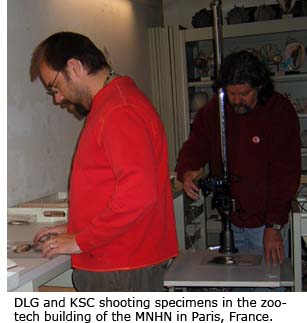 20 May-3 June 2006. — The MUSSELp visits the Muséum National d'Histoire Naturelle in Paris to capture more specimen records. We spent two weeks in Paris capturing specimen records at the MNHN, a very old museum with many important collections stashed away in its various cabinets. For most of the first week, we were stationed in the Malacologie Department, shooting types in the sunlit type room. But, for the remainder of our Paris adventure, we worked through the non-type specimens three floors below ground in the zoothec "bunker" across the street. 20 May-3 June 2006. — The MUSSELp visits the Muséum National d'Histoire Naturelle in Paris to capture more specimen records. We spent two weeks in Paris capturing specimen records at the MNHN, a very old museum with many important collections stashed away in its various cabinets. For most of the first week, we were stationed in the Malacologie Department, shooting types in the sunlit type room. But, for the remainder of our Paris adventure, we worked through the non-type specimens three floors below ground in the zoothec "bunker" across the street.
The MNHN forced us to reevaluate our normal data capture protocol. Typically, DLG shoots the specimen images while KSC enters the data into the MUSSELp Database. However, because of the sheer volume of material, we both shot the specimen images, with text entry to wait until we were back in our offices.
Over all, we captured images from over 1500 lots of freshwater musssel from South America, Central America and Africa. Among the specimens photographed were numerous types that we had never seen before. Our visit to Paris and MNHN provided some of the last data necessary to revise numerous African freshwater mussel species concepts. |
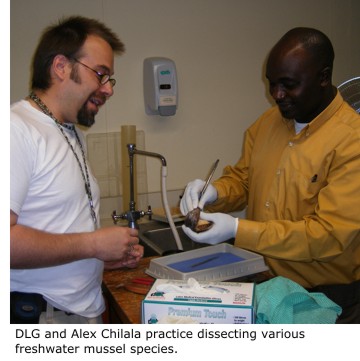 1-14 May 2006. — Great strides in the advancement of MUSSELp collaborations! During the first two weeks of May, Alex Chilala visited the Academy of Natural Sciences from Zambia. The purpose of Alex's trip to Philadelphia was to work with DLG to get a handle on freshwater mussel biology and taxonomy and to foster collaboration between American and African scientists. During his stay, Alex also presented a lecture to the Institute for African Pumzikio & Exploration. 1-14 May 2006. — Great strides in the advancement of MUSSELp collaborations! During the first two weeks of May, Alex Chilala visited the Academy of Natural Sciences from Zambia. The purpose of Alex's trip to Philadelphia was to work with DLG to get a handle on freshwater mussel biology and taxonomy and to foster collaboration between American and African scientists. During his stay, Alex also presented a lecture to the Institute for African Pumzikio & Exploration.
From the ANSP, Alex Chilala went to Cornell University to work with John Friel as part of the All Catfish Species Inventory.
And, speaking of collaboration, DLG, Melanie Stiassny and Bob Schelly were recently funded by the National Science Foundation to conduct a biotic survey of the Lower Congo River, "Evolution in a Vortex: An Inventory of the Fishes and Mollusks of the Lower Congo River Rapids." Melanie and Bob, respected ichthyologists at the American Museum of Natural History in New York, have been working in the Congo Basin for the last few years. Adding sampling for freshwater mollusks to the mix will likely result in the team uncovering some really interesting biological interactions. While Congalese mussels are presumably parasitic upon fishes, the details of the symbioses have not be investigated. |
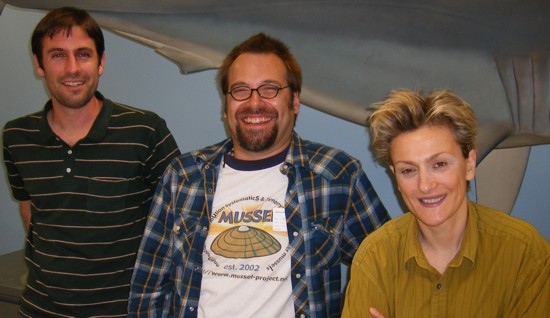
Bob Schelly, DLG and Melanie Stiassny.
|
|
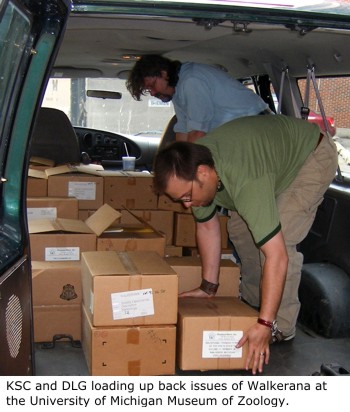 3 May 2006. — A New Species and a New Life for a Journal. The month of April 2006 was significant because there were no MUSSELp research trips. We have been on the go since last fall, and it was nice to get caught up on work in our own collections. KSC and DLG did make a short trip to Ann Arbor to oversee the transfer of most of the back issues of Walkerana from Jack Burch at the University of Michigan Museum of Zoology to the Freshwater Mollusk Conservation Society. KSC is the editor-in-chief of Walkerana, and he is ready to take your submissions! 3 May 2006. — A New Species and a New Life for a Journal. The month of April 2006 was significant because there were no MUSSELp research trips. We have been on the go since last fall, and it was nice to get caught up on work in our own collections. KSC and DLG did make a short trip to Ann Arbor to oversee the transfer of most of the back issues of Walkerana from Jack Burch at the University of Michigan Museum of Zoology to the Freshwater Mollusk Conservation Society. KSC is the editor-in-chief of Walkerana, and he is ready to take your submissions!
The first new species described from our MUSSEL Project work was published in the Proceedings of the Academy of Natural Sciences: Mutela wistarmorrisi. The species is known from the Cuanza River in Angola. The article includes not only a description and diagnosis of M. wistarmorrisi, but also accounts of all the freshwater mussels known or suspected to occur in that country. Twenty-three species in three families are known from the Angola Region.
The new species, Mutela wistarmorrisi, was named for I. Wistar Morris of Philadelphia for his generous contributions to the Academy of Natural Sciences through both philanthropy and leadership. |
|
 3-16 March 2006. — The 16th Annual Meeting of the Egyptian German Society of Zoology, Egypt. DLG was invited by Drs. Gamil Soliman and Maher Khalifa of Cairo University in Giza, Egypt to participate in the annual meeting of the Egyptian German Society of Zoology in Fayid, Egypt. As part of the plenary lectures on the first day (5 March), DLG presented his talk, "Freshwater Mussel (Mollusca: Unionoida) Diversity in Africa, with an Emphasis on the Nile Fauna". The talks continued through 8 March. 3-16 March 2006. — The 16th Annual Meeting of the Egyptian German Society of Zoology, Egypt. DLG was invited by Drs. Gamil Soliman and Maher Khalifa of Cairo University in Giza, Egypt to participate in the annual meeting of the Egyptian German Society of Zoology in Fayid, Egypt. As part of the plenary lectures on the first day (5 March), DLG presented his talk, "Freshwater Mussel (Mollusca: Unionoida) Diversity in Africa, with an Emphasis on the Nile Fauna". The talks continued through 8 March.
One of the most important events of the meetings was the lecture by Dr. Kohar Garo describing the early larval development of Mutela rostrata. We look forward to seeing that work published, as the larvae for almost all iridinids is unknown.
At Cairo University, DLG participated in various lectures, examined specimens, and collaborated with Dr. Kohar and Mona Fathy, initiating Mashrua Al Mahar — the Egyptian satellite of the MUSSEL Project.

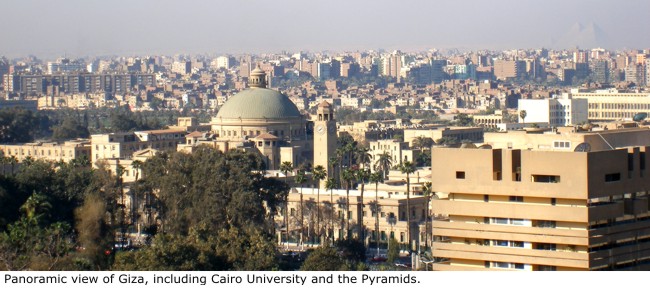
|
 22 January - 3 February 2006. — Collections work at the Humboldt University Museum für Naturkunde in Berlin, Germany. Continuing our exploration of European malacology collections, we spent nearly two weeks working through the mussels housed in the Institut für Systematische Zoologie in Berlin. 22 January - 3 February 2006. — Collections work at the Humboldt University Museum für Naturkunde in Berlin, Germany. Continuing our exploration of European malacology collections, we spent nearly two weeks working through the mussels housed in the Institut für Systematische Zoologie in Berlin.
Our data capture proceeded normally, with KSC capturing text strings and DLG digitally photographing each lot. In all, we mined the collection for about 1300 more records for the MUSSEL Project Database. That includes 120 lots of primary and secondary types of various freshwater mussel species from around the world. The remaining records refer to specimens of the Hyriidae, Etheriidae, Iridinidae and Mycetopodidae on the southern continents, as well as various Unionidae in Africa and Central America.
On Friday 27 January, DLG presented an overview of our project to a group of malacology students and postdocs, and that was followed up the next week with a demonstration of the MUSSEL Project Database to some of the curators, including Matthias Glaubrecht, curator of mollusks. |
|